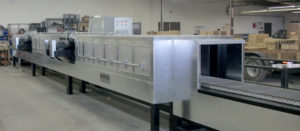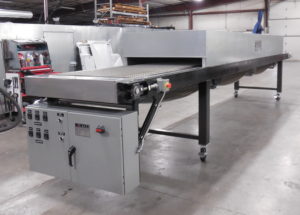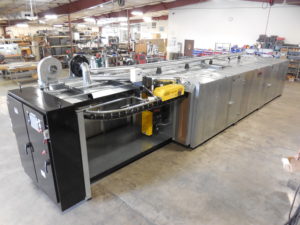
By: Ed Sullivan
What options to consider when ovens are underperforming due to heat deficiencies?
As industrial ovens, dryers and heaters age, questions normally arise about their performance. Are they generating insufficient heat? Are they performing inefficiently? Is there a more cost-effective way to produce more heat? Do I need to replace or refurbish the oven?
Whether ovens are gas or electric, convection or infrared, there are several variables that must be considered before deciding to refurbish or replace your present equipment.
 Once an industrial oven goes past its useful life it loses efficiency, which can raise heating costs, delay production, or compromise product quality. But before replacing the entire oven with a new unit, users should consider whether refurbishing with an oven retrofit, or upgrading the oven with supplemental heaters, would provide major cost savings and resolve oven underperformance.
Once an industrial oven goes past its useful life it loses efficiency, which can raise heating costs, delay production, or compromise product quality. But before replacing the entire oven with a new unit, users should consider whether refurbishing with an oven retrofit, or upgrading the oven with supplemental heaters, would provide major cost savings and resolve oven underperformance.
“One of the first questions to ask is whether or not the heating requirements have changed,” advises Jesse Stricker, founder of INTEK Corporation (Union, MO). INTEK is a manufacturer of heaters and elements for industrial ovens and dryers used in continuous process heating for production automation and material handling in a wide range of industries.
“It is not unusual for a metalworking company, thermoformer, or manufacturer that bakes paint or other coatings onto product surfaces to make changes in processes or materials subjected to heating or curing requirements,” says Stricker. “When such changes occur, it’s quite possible that oven and heater specifications may need to be upgraded.”
Oven Conditions
More often there are situations where ovens suffer wear and tear from years of use, and the question may be whether to repair or replace the existing system. Stricker recommends that there are a few “conditions” that should be addressed before making that decision.
Condition of current oven: Is it sound mechanically? Ovens usually consist of sheet metal and a structural steel framework. If the structural steel framework and sheet metal is sound, not rusty, perforated or otherwise deteriorated or unstable mechanically, that would indicate that the oven could be refurbished.
Condition of ductwork: If the oven is a convection design, is the ductwork in good condition? If the ductwork is in good condition, not perforated with multiple holes, then it is most likely distributing the heat throughout the oven as designed. This may be handled as part of the sheet metal analysis.
Condition of mechanical systems: Is the recirculating blower well maintained and fully operational? Is the exhaust blower in sound condition?
Condition of elements that tie into mechanical systems: These elements must be evaluated, including the heating system, whether gas or electric.
“If none of those factors are in good shape, the decision is obvious: you should replace the oven,” Stricker says. “If some of those factors are in good shape, you will often find that refurbishing the oven is the best solution. But if all of those factors are satisfactory, yet the oven seems to be producing insufficient heat, the oven will likely need to be reinforced with supplemental heaters.”
 Supplementing Ovens
Supplementing Ovens
There are several ways to supplement ovens that provide inadequate heat. In many situations it is advisable to place a pre-heat section directly adjacent to the front end of the oven. This is often done with infrared heaters, although convection heaters are also usually effective.
“Supplementing an oven with a pre-heating process can be a rather straightforward process, although it is advisable that users enlist the support of a vendor or other specialist to help determine the most efficient and economical solution for the user’s specific requirements,” recommends Stricker.
He adds that preheating requires positioning a number of heater modules in an add-on oven chamber – a sort of vestibule – that is constructed in front of the original oven. Infrared heaters are often a very practical solution for this methodology, because each of these heaters can be zoned independently to target weak heating areas that the existing oven does not address.
“This amounts to heating the product load in areas that the main oven was not able to handle, in advance of the load entering that main oven chamber, in order to achieve the wanted results,” Stricker explains.
Stricker points out that infrared heating is also more energy efficient, cheaper to operate, provides controllable heat, and is significantly more environmentally friendly. But if correctly designed, either infrared or convection heating may provide an effective pre-heat supplemental system.
In the case of an existing monorail conveyor-fed oven, which carries products on a vertical axis, heaters can be placed in front of the main oven on both sides of the conveyor in order to provide balanced heat to the products as they travel down the line to the oven.
The same principal can be applied to belt conveyor-fed ovens. However, because products are traveling to the oven on a horizontal belt, the heaters are often placed over the top and under the bottom of the conveyor belt.
“Whichever pre-heat method you choose, the benefit is that heat absorbed by products is carried into the oven, thereby enhancing the operation of the main oven,” says Stricker.
Refurbishing Underperforming Ovens
 Sometimes repairs can be as simple as installing required replacement parts such as high-temperature insulation, porcelain terminal blocks, heat controls, or heating elements. Even when refurbishing is required, that solution can be considerably less expensive than purchasing a new oven.
Sometimes repairs can be as simple as installing required replacement parts such as high-temperature insulation, porcelain terminal blocks, heat controls, or heating elements. Even when refurbishing is required, that solution can be considerably less expensive than purchasing a new oven.
“Updating industrial oven heaters or heating elements can often boost oven performance to its original specs or even improve them,” says Stricker. “Some oven manufacturers engineer modules that will fix a performance problem, yet are easy enough for self-installation.”
Stricker adds that his company has saved customers as much as $100,000 in the refurbishment of an underperforming oven. In a typical instance his staff performed the engineering tasks, and the customer handled the removal of the old heaters and installation of new infrared units.
Maintenance Issues
Some heating system designs rely on reflectors to mirror heat waves onto parts from a position adjacent from the heat source, thereby reducing energy costs. If those reflectors are not cleaned on a regular basis, they will lose significant efficiency. However, maintaining the reflective surface can be an ongoing chore.
“Infrared heaters don’t rely on having a shiny reflective surface,” Stricker explains. “They remain efficient regardless of cleanliness because the infrared heat travels in waves that reflect off any surface.”
Also, many infrared heaters operate at temperatures high enough to ensure that products can go quickly through the process with no loss of efficiency. Since infrared heaters have no moving parts, there is virtually no preventive maintenance required.
Infrared heaters don’t have any moving parts, and they provide a relatively long service life (e.g., INTEK infrared heaters are designed to provide a 10-year lifespan).
Another infrared maintenance advantage: when using infrared heaters in an oven it isn’t necessary for service workers to enter the oven. Service personnel can take care of all of the repair and replacement activities from outside of the oven, which is a significant safety advantage.
For more information, contact INTEK Corporation, 290 Independence Drive, Union, MO 63084; Phone: Phone: 636-584-8500, Toll Free: 800-387-8559; Fax: 636-584-8503; Email: sales@intekcorp.com; or visit the web site: www.intekcorp.com




















